- What Are Crime Alert Mobile Apps?
- How Crime Alert Apps Work?
- Reasons Behind The Market Growth Of Crime Alert Apps
- Must-Have Features In A Crime Alert App
- How To Develop A Crime Alert App?
- How Businesses Can Monetize Their Crime Alert App?
- Top 5 Crime Alert Apps In The Market Right Now
- Tech Stack To Consider To Develop A Crime Alert App
- Conclusion
- How Idea Usher Can Help With Crime Alert App Development?
- FAQ
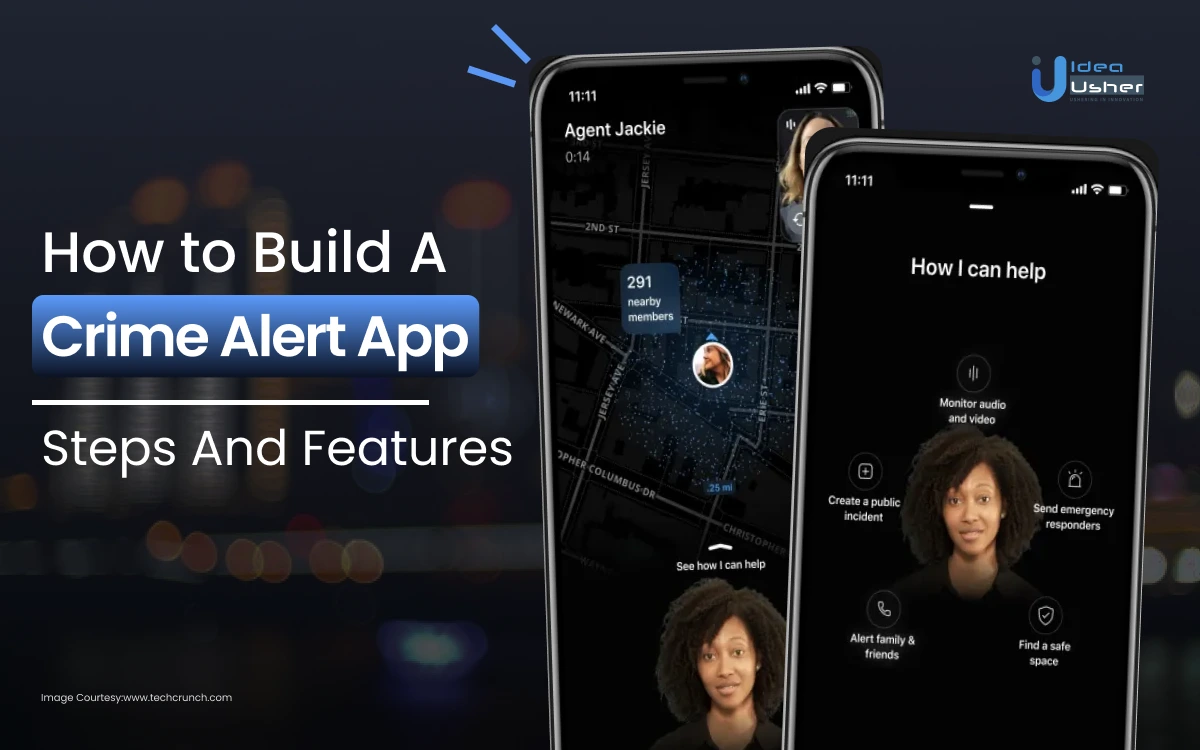
In an era where crime activity is on the rise, remaining informed about potential risks is critical to personal protection. Robberies, murders, kidnappings, and other crimes dominate daily media headlines.
Consider a scenario in which you receive real-time notification of crime activity in your area, allowing you to proactively protect your life and prevent a crime from occurring.
This is where the idea of a crimel alert smartphone app comes into play. Such apps provide a proactive solution by harnessing current technology and expertise to help individuals and their loved ones stay secure from various crimel activities such as theft, pickpocketing, burglary, abduction, shootings, and more.
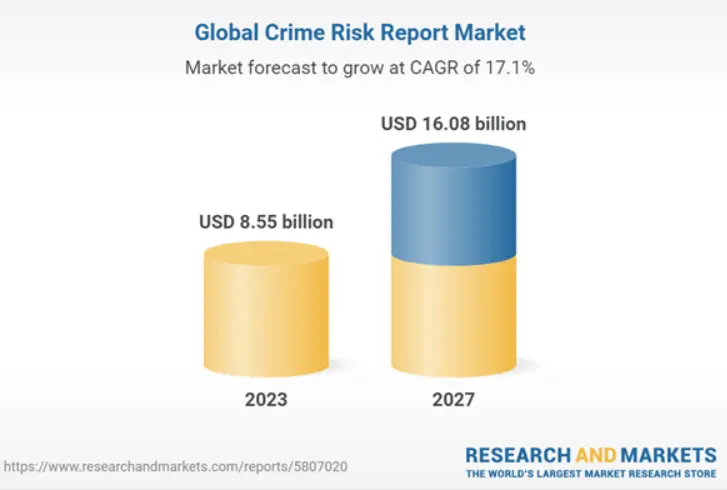
Source: ResearchAndMarkets
Given the growing demand for individual safety, now is an excellent time to develop a crime alert app. If you want to invest in crime alert app development services, you’ve come to the right place.
This article aims to provide insights into the development process, essential features, and benefits of developing a crime alert app.
- What Are Crime Alert Mobile Apps?
- How Crime Alert Apps Work?
- Reasons Behind The Market Growth Of Crime Alert Apps
- Must-Have Features In A Crime Alert App
- How To Develop A Crime Alert App?
- How Businesses Can Monetize Their Crime Alert App?
- Top 5 Crime Alert Apps In The Market Right Now
- Tech Stack To Consider To Develop A Crime Alert App
- Conclusion
- How Idea Usher Can Help With Crime Alert App Development?
- FAQ
What Are Crime Alert Mobile Apps?
Crime alert mobile apps are specialized applications designed to enhance personal safety and community security by leveraging technology to provide real-time information about potential threats or crime activities in a specific area. These apps serve as a proactive tool to keep users informed and empower them to make informed decisions to mitigate risks. Typically, users can submit reports of suspicious activities or incidents through the app, contributing to a collective effort to enhance community vigilance.
These applications extract data from various sources, including user-generated reports, law enforcement databases, and public records, to create a comprehensive and dynamic database of potential crime activity. The integration of GPS and geolocation technology allows these apps to deliver personalized alerts to users based on their proximity to reported incidents. Push notifications ensure timely awareness, providing users with immediate updates about potential threats in their designated areas along with safety recommendations.
Crime alert apps often encourage community participation by fostering communication among users. Users can share safety tips, report incidents, and engage in discussions about local events, creating a network of vigilant residents actively contributing to community safety. Some of these apps may also integrate seamlessly with local emergency services, allowing users to access emergency contact information and seek help directly from the app, reducing response times during critical situations. Overall, crime alert mobile apps represent a powerful intersection of technology and community engagement, working together to enhance public safety in the digital age.
How Crime Alert Apps Work?
Crime-alert smartphone applications act as mindful guardians in the digital age, using modern technology to keep users informed and protected. Here are how Crime alert apps work:
1. User Reports for Community Vigilance
Crime alert mobile applications rely on user-generated reports to enhance community vigilance. Users can actively contribute to the safety of their surroundings by submitting reports of suspicious activities or incidents through the application. These reports typically include critical details such as the location of the event, and a description of the incident, and may be supplemented with relevant images or videos. By harnessing the power of collective observations, these apps create a dynamic and participatory environment where users play a vital role in keeping their communities safe.
2. Comprehensive Insights
Crime alert apps go beyond user reports by aggregating data from diverse sources, including law enforcement databases and public records. The application processes this information to create a comprehensive and dynamic database of potential crime activity. By incorporating data from multiple channels, the app ensures a more holistic view of the safety landscape. This aggregated data serves as the foundation for generating real-time alerts and allows users to access a more complete picture of potential threats in their vicinity.
3. Geolocation Technology for Personalized Alerts
The core functionality of crime alert apps lies in their utilization of GPS and geolocation technology. These apps track users’ locations in real-time, enabling the delivery of personalized alerts based on proximity to reported incidents. Users can define specific geographic areas of interest, and the app, using geolocation data, ensures that they receive timely notifications relevant to their current location. This personalized approach enhances the user experience, providing them with information that directly impacts their immediate surroundings.
4. Push Notifications for Timely Awareness
Crime alert apps employ push notifications to deliver timely and relevant information to users. When the app detects potential threats or crime activity in the designated areas chosen by the user, it sends push notifications to their devices. These notifications not only include details about the reported incidents but also provide safety recommendations. The use of push notifications ensures that users stay informed in real-time, empowering them to make immediate decisions regarding their safety based on the latest available information.
5. Community Participation and Information Sharing
Many crime alert apps actively promote community participation by fostering communication among users. Through these platforms, users can engage with each other, share safety tips, and discuss local events. This collaborative approach strengthens the sense of community and increases overall awareness. By encouraging information sharing, these apps create a network of vigilant residents who actively contribute to the safety and well-being of the community. The social aspect of the app complements its technological features, making it a holistic tool for community-driven safety.
6. Integration with Emergency Services
In some instances, crime alert apps are seamlessly integrated with local emergency services. This integration allows users to access emergency contact information and initiate a call for help directly from the app. This streamlined connection between the app and emergency services significantly reduces response times during critical situations, enhancing the overall effectiveness of the app in ensuring user safety. The integration with emergency services exemplifies how technology can be leveraged to provide swift assistance when needed most.
7. Real-time Updates for Continuous Monitoring
To maintain the effectiveness of the app, continuous updates to the database are crucial. Crime alert apps ensure that the information provided to users is always up-to-date by continuously refreshing the database with the latest data. This real-time updating process guarantees that users receive the most current information about potential threats and crime activities in their area, reinforcing the app’s role as a reliable and dynamic tool for personal safety.
Reasons Behind The Market Growth Of Crime Alert Apps
Crime alert apps have witnessed a remarkable surge in popularity, becoming indispensable tools for personal safety. Explore the key factors propelling the market growth of these apps,
1. Real-Time Alerts
Crime alert apps stand out due to their ability to deliver real-time alerts, ensuring users receive immediate updates on crime activities, emergencies, or potential threats in their vicinity. This prompt information empowers individuals to make well-informed decisions swiftly, such as altering routes, avoiding specific areas, or taking precautionary measures to enhance personal safety. The rapid dissemination of crucial information underscores the importance and necessity of developing such apps in our contemporary digital landscape. However, it is imperative to consider the development cost for a crime alert app to establish a realistic budget for the project.
2. Community Collaboration for Enhanced Safety
A notable feature of crime alert apps is their role in fostering community collaboration. These applications serve as digital platforms where users can actively share information, report incidents, and exchange experiences related to safety and security. By promoting a collective approach, crime alert apps contribute to the formation of strong community bonds. Residents become part of a vigilant network, collaborating to improve overall safety through the sharing of vital information and safety tips. This collaborative aspect strengthens the social fabric, making crime alert apps indispensable tools for community welfare.
3. Location-Based Services
Crime alert apps leverage the GPS capabilities of smartphones to provide location-based services, tailoring notifications to the user’s specific surroundings. Whether users are at home, work, or traveling, they can customize alarm settings to receive relevant and up-to-date information. This adaptability ensures that individuals are informed about events in their immediate vicinity, enhancing their situational awareness and enabling them to take appropriate actions based on their location. The integration of location-based services adds a crucial layer of personalization to crime alert apps, making them more effective in addressing users’ safety concerns.
4. Crime Mapping and Analysis
Beyond real-time alerts, crime prevention apps often offer features such as crime mapping and statistical analysis. Users can access visual representations of crime data in their area, helping them identify patterns and trends. This analytical component not only improves individual situational awareness but also aids law enforcement agencies in allocating resources effectively. By identifying high-risk areas and understanding crime patterns, authorities can implement targeted crime prevention strategies. Crime mapping and analysis, therefore, play a pivotal role in creating safer communities by providing valuable insights to both residents and law enforcement agencies.
5. Emergency Response Integration
A key strength of crime alert apps lies in their seamless integration with emergency response services. In critical situations or imminent threats, users can instantly connect with local authorities and emergency services directly through the app. This integration streamlines the process of seeking help, reducing response times and potentially saving lives. The ability to quickly and efficiently link users with emergency services enhances the overall effectiveness of crime alert apps as tools for personal safety. The seamless connection between users and emergency responders underscores the vital role these apps play in ensuring swift assistance during emergencies.
Must-Have Features In A Crime Alert App
Crime alert applications can help empower communities and individuals. Explore the must-have characteristics that make these applications vital for improving public safety and reaction time.
1. Real-time Incident Reporting
In the realm of crime alert applications, real-time incident reporting stands out as a cornerstone feature. The functionality to swiftly and directly report suspicious activities, crimes, and emergencies empowers users to actively contribute to community safety. This real-time reporting not only aids in fostering a responsive law enforcement environment but also facilitates a quicker and more efficient handling of incidents. To enhance the implementation of this crucial feature, collaboration with an on-demand app development company can provide expertise and streamline the integration process.
Efficient reporting systems should allow users to provide detailed information, attach images or videos, and choose the appropriate incident category. Ensuring user anonymity and privacy is equally important to encourage widespread reporting without fear of retaliation.
2. Geofencing and Safe Zones
Geofencing and the establishment of safe zones form a vital part of a comprehensive crime alert app. It empowers users to define specific geographic boundaries and receive alerts when incidents are reported within those predefined areas. Incorporating safe zones allows users to designate locations where they feel secure, such as their homes or workplaces. This feature not only enhances personal safety but also provides a customizable and adaptive security experience for each user.
Implementation of geofencing should consider user-friendly customization, allowing individuals to easily set and modify boundaries. Safe zones can be further augmented by enabling users to share their safe zone data with trusted contacts for an added layer of security.
3. Multi-layer Alert System
A resilient crime alert app employs a multi-layer alert system tailored to different user types and scenarios. This can encompass visual alerts, push notifications, and even audio alerts to ensure information reaches users in diverse situations. Customizable settings empower users to personalize the type and intensity of notifications they receive, accommodating various preferences and sensitivities.
For instance, users might opt for discreet notifications in certain situations and more prominent alerts during emergencies. Collaboration with experienced mobile app developers is crucial to seamlessly integrate and fine-tune this multi-layered alert system.
4. Community Collaboration Platform
Building a sense of community is integral to the success of any security-focused application. Integrating a community collaboration platform within the crime alert app encourages users to actively share information, tips, and updates. Features like chat functionalities and community forums facilitate open communication, fostering a network of vigilant users working collaboratively to enhance community safety.
Community collaboration platforms can also include features like neighborhood watch groups, allowing users to form localized communities for more targeted information sharing. Implementing this feature effectively necessitates the expertise of Android app developers to create a user-friendly and engaging community interface.
5. Augmented Reality Integration
Augmented Reality (AR) integration serves as a cutting-edge feature for crime alert apps, significantly improving situational awareness. By overlaying real-time crime data onto the user’s surroundings through a smartphone camera, AR enables users to visually identify potential risks and incidents nearby. This technology transforms the user’s device into a powerful tool for navigating unfamiliar areas and responding effectively to new situations.
AR integration can include features like live crime scene visualization or location-based information overlays. To implement this advanced technology seamlessly, collaboration with skilled developers familiar with AR applications is essential.
6. Emergency Call Button
Seamlessly integrating an emergency call button into the crime alert app is paramount for user safety. In times of crisis, users should have the ability to swiftly contact local authorities and emergency services directly through the app, streamlining the help-seeking process. This feature reduces response times and provides users with immediate support when needed.
Ensuring the emergency call button is easily accessible, even in stressful situations, is crucial. Collaboration with mobile app developers well-versed in creating intuitive user interfaces is essential to enhance the usability of this critical feature.
7. Analytical Dashboards and Crime Trends
Equipping users with access to analytical dashboards showcasing crime trends and patterns enhances the overall utility of a crime alert app. Visual representations, such as heatmaps and statistical analyses, provide users with valuable insights to make informed decisions about their safety. Additionally, these dashboards serve as a powerful tool for law enforcement agencies to implement targeted crime prevention strategies based on identified trends.
Implementation of analytical dashboards should prioritize user-friendly interfaces, allowing individuals to easily interpret and navigate through the presented data. Collaborating with experienced developers can ensure the seamless integration of this feature, contributing to the overall effectiveness of the crime alert app.
How To Develop A Crime Alert App?
Discover the key steps and considerations in developing crime alert app tool to keep citizens informed and connected against crime.
1. Develop a Comprehensive Plan and Vision
Before diving into the development process, it’s crucial to meticulously plan your crime alert app. Identify the primary purpose of your application—is it solely for crime alerts, or does it include additional features? Define a clear vision for your app, specifying the problems it aims to solve and the value it provides to users. Choose the platform you want to target first, whether it’s iOS, Android, or both. A well-thought-out plan will serve as a roadmap for the entire development process.
When determining the vision behind your crime alert app, consider factors such as user interface design, ease of use, and the overall user experience. Consider incorporating features that set your app apart from existing ones in the market. This planning phase is the foundation of your app development journey, ensuring that you have a clear direction and purpose.
2. Conduct In-Depth Market Research
Conduct thorough market research to gain insights into the industry and understand the competition. Identify existing crime alert apps and study their features, strengths, and weaknesses. Analyze user reviews to discern what users like and dislike about these apps. This research will help you identify opportunities for improvement and innovation. Additionally, explore potential partnerships or integrations that can enhance the functionality of your app.
Understanding the competitive landscape is essential for creating a unique selling proposition (USP) for your app. Identify the gaps in the market and how your app can address them. Consider user feedback as valuable input for refining your app’s features and ensuring it meets the specific needs of your target audience.
3. Assemble a Skilled Development Team
Hiring a dedicated and skilled development team is critical for turning your vision into a functional app. Collaborate with developers who not only possess technical expertise but also understand your goals and vision. Communication is key during this phase—regularly discuss your requirements, desired features, and expectations with the development team. Building a strong partnership with your developers ensures a smoother development process and increases the likelihood of a successful outcome.
Encourage an agile development approach, allowing for flexibility and iterations throughout the process. This collaborative approach ensures that the final product aligns with your initial vision while accommodating any necessary adjustments.
4. Demand and Evaluate the Prototype
Once your development team creates a prototype, carefully evaluate its user interface, features, and overall functionality. The prototype serves as a visual representation of your app and allows you to identify potential improvements before the full development process begins. Ensure that the prototype aligns with your vision and meets the expectations you’ve set for the app’s performance.
During this phase, seek feedback from potential users or stakeholders to gather valuable insights. Address any concerns or suggestions, as making changes at the prototype stage is more cost-effective than modifying a fully developed app. The prototype evaluation process is crucial for refining and perfecting your crime alert app before moving forward.
5. Thoroughly Test the Developed App
After the development phase is complete, it’s time to rigorously test your crime alert app. Testing is a critical step to identify and rectify any bugs, glitches, or performance issues. Conduct both functional and usability testing to ensure the app operates smoothly and meets user expectations. Utilize testing tools and methodologies to perform comprehensive quality assurance.
Engage in beta testing with a selected group of users to gather real-world feedback and identify any potential issues that may not have been evident during internal testing. This user feedback is invaluable for making final adjustments to enhance the app’s stability and user experience.
Remember that a thoroughly tested app is more likely to gain positive reviews and retain users. Prioritize the elimination of any issues that could negatively impact the user’s interaction with the crime alert app.
6. Deploy and Market the App Strategically
With a fully tested and refined app, it’s time to deploy it on the respective app stores—Google Play Store for Android and the Apple App Store for iOS. Follow the platform-specific guidelines for submission and ensure your app complies with all necessary regulations and policies.
Simultaneously, implement a comprehensive marketing strategy to promote your crime alert app. Leverage various marketing channels, such as social media platforms, to create awareness and generate interest in your app. Craft engaging content that highlights the app’s unique features, benefits, and its contribution to enhancing public safety.
Consider partnerships with law enforcement agencies, community organizations, or other relevant entities to increase visibility and credibility. Utilize online advertising, press releases, and promotional events to attract attention to your app. A well-executed marketing strategy is crucial for reaching a wide audience and encouraging downloads.
7. Gather User Feedback and Implement Updates
Post-launch, actively seek user feedback through reviews, surveys, and direct communication. Analyze this feedback to identify areas for improvement or additional features that users may desire. Implement regular updates to address user concerns, enhance functionality, and stay ahead of evolving security needs.
Maintaining open communication with your user base fosters trust and loyalty. Consider creating a feedback loop, where users feel heard and valued. This iterative approach to app development ensures that your crime alert app remains relevant and effective over time.
How Businesses Can Monetize Their Crime Alert App?
From subscription models to partnerships and innovative features, a diverse array of strategies can be employed to effectively monetize these apps while contributing to community well-being.
1. Subscription Models
In a subscription-based model, businesses can entice users with a free version of the crime alert app that offers basic features. The premium subscription can then unlock advanced functionalities such as real-time alerts, extended historical data access, and personalized safety recommendations. Users opting for the subscription plan can enjoy an enhanced and comprehensive safety experience, creating a recurring revenue stream for the business.
2. In-App Advertising
Partnering with local businesses, security services, and relevant advertisers allows the crime alert app to display targeted ads within the platform. Advertisers can tailor their messages to the app’s user base, enhancing engagement. This advertising revenue can support the app’s maintenance costs and potentially fund further feature development, ensuring the app remains a valuable resource for users.
3. Partnerships with Law Enforcement Agencies
Establishing strategic partnerships with law enforcement agencies adds credibility to the app and provides an additional revenue stream. Charging these agencies a fee for access to the app’s data, analytics, or exclusive features can contribute to community safety initiatives. The collaboration can also lead to improved communication channels, benefiting both the app users and law enforcement efforts.
4. API Integration for Third-Party Apps
Monetizing the crime alert app through APIs opens opportunities for collaboration with third-party apps or services. By offering APIs for integration, businesses can attract other platforms looking to enhance their services with safety features. Charging a licensing fee or subscription for API services provides a scalable revenue stream while expanding the reach and impact of safety features across various applications.
5. Data Analytics and Insights
Leveraging the data collected by the app enables the provision of analytics and insights to businesses, local governments, or urban planners. Offering detailed reports on crime trends, safety hotspots, and demographic information provides valuable decision-making tools. Charging a fee for access to these insights ensures a sustainable revenue source, while organizations benefit from informed strategies for improving community safety.
Top 5 Crime Alert Apps In The Market Right Now
Explore the top 5 crime alert applications that provide users with real-time alerts and preventive actions to maintain an attentive and safe environment.
1. Citizen
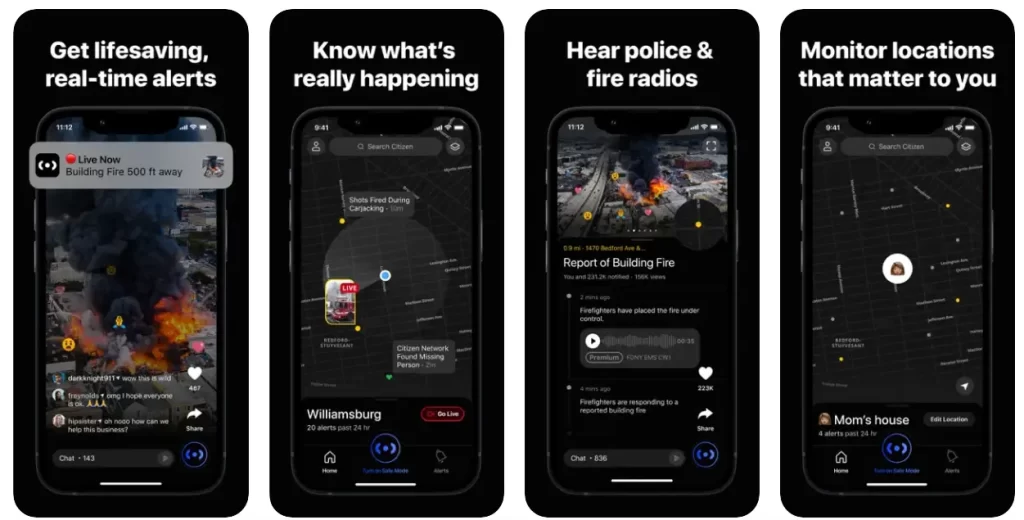
Citizen, a longstanding crime report app, has garnered a user base exceeding 9 million people by providing quick and real-time life-saving alerts. With over 10 billion security and crime alerts sent, the app emphasizes creating a safer living environment for its users. Notably, Citizen incentivizes users to livestream crimes and incidents in their vicinity. The platform’s commitment to real-time updates and a large user base contributes to its effectiveness in enhancing community safety.
2. SpotCrime
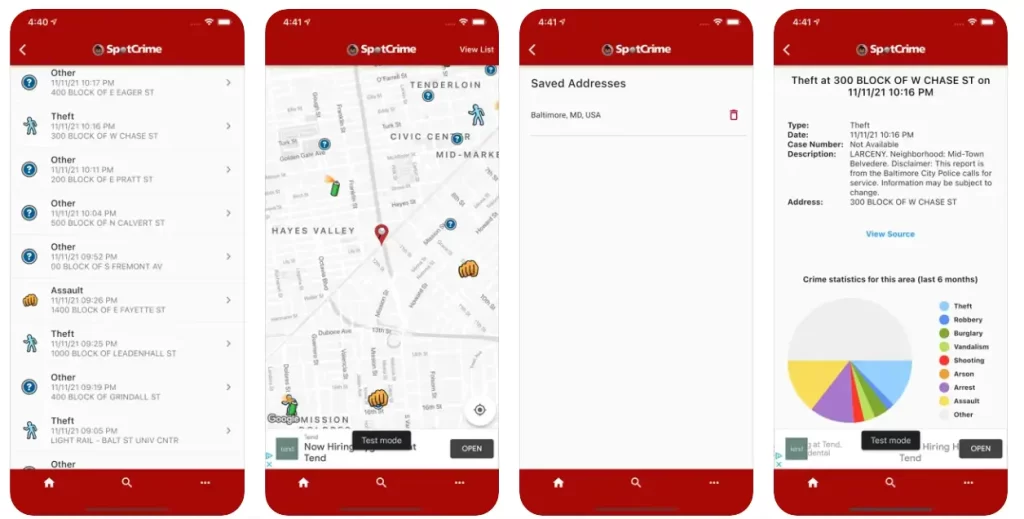
For individuals keen on staying informed about their surroundings, SpotCrime serves as a valuable crime mapping website. This platform delivers timely alerts and notifications regarding crime activities in specific neighborhoods, aiding users in staying updated and vigilant. SpotCrime goes beyond alerts by providing comprehensive reports and statistics, allowing users to analyze crime trends and actively contribute to promoting public safety on a broader scale.
3. Nextdoor
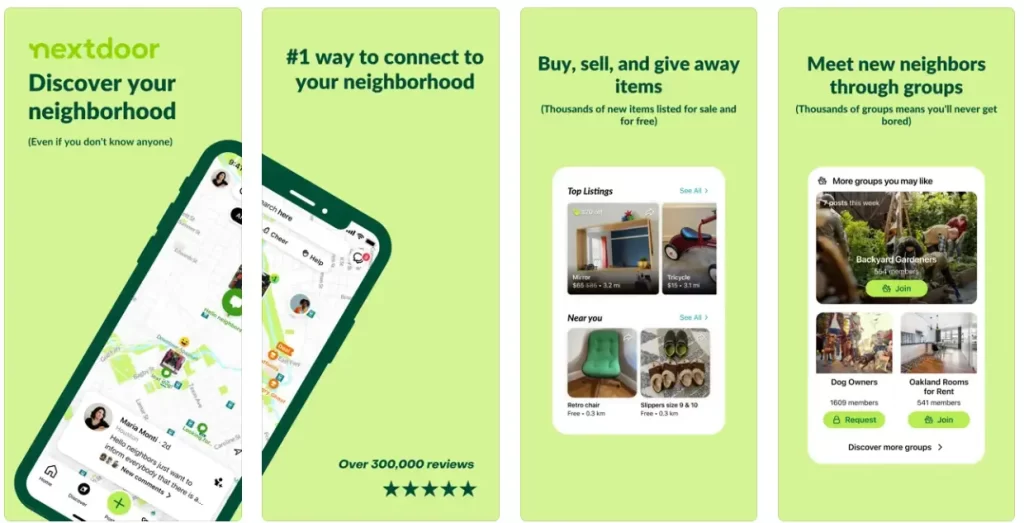
Nextdoor, a well-known platform connecting neighbors, extends its utility beyond community engagement. While facilitating connections and resource-sharing among neighbors, Nextdoor also integrates safety features. It enables police departments to send targeted messages to nearby communities, notifying them about various incidents such as burglaries, kidnappings, and thefts. By seamlessly blending social connectivity with safety features, Nextdoor plays a dual role in enhancing neighborhood security.
4. ActiveAlert
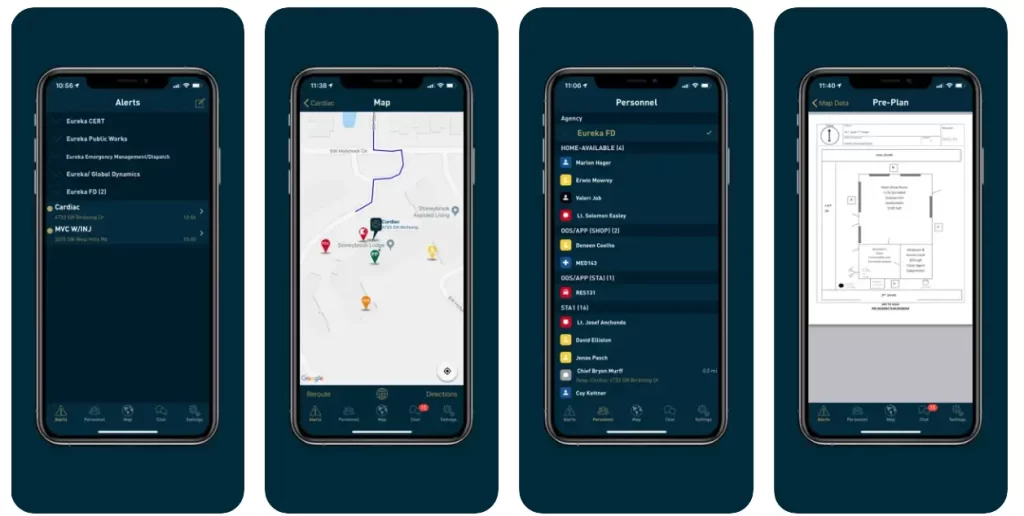
ACTIVE911, or ActiveAlert, stands out as a reliable and powerful crime alert app designed to facilitate response coordination in emergency situations. The app offers innovative features like map data and pre-plans, CAD (Computer-Aided Dispatch) connection, and rapid alerting and responses. ActiveAlert aims to equip first responders with tools and data crucial for responding swiftly in critical missions. Its commitment to providing essential resources in emergency scenarios contributes to its effectiveness in supporting public safety.
5. Crimewatch
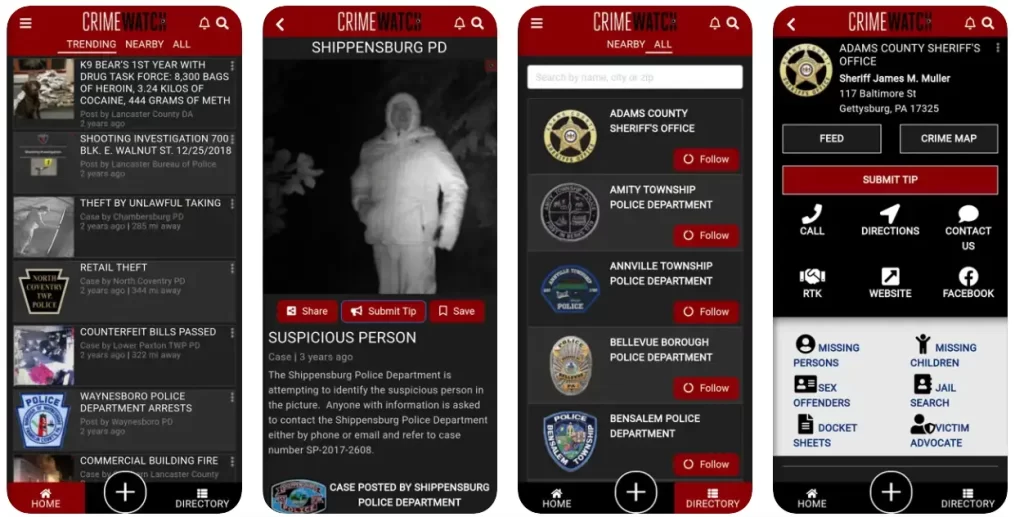
True to its name, Crimewatch serves as a crime-spotting app designed to aid law enforcement in reducing crime activities and promoting public protection. Beyond assisting law enforcement, Crimewatch acts as a transparent source for disseminating information to the public. By fostering trust and transparency, the app contributes to the collaborative effort between communities and police departments to create safer environments. Crimewatch emerges as a comprehensive solution for both crime tracking and public awareness.
Tech Stack To Consider To Develop A Crime Alert App
Developing a crime Alert App involves various components and technologies to ensure effective communication, user engagement, and data security. Here’s a suggested tech stack for developing a crime Alert App:
1. Frontend Development
- Framework: React Native (for cross-platform mobile app development)
- Programming Language: JavaScript/TypeScript
- UI Framework: Material-UI, Ant Design, or a similar framework for a consistent and responsive design.
2. Backend Development
- Server-side Framework: Express.js (Node.js) or Django (Python)
- Programming Language: Node.js (JavaScript/TypeScript) or Python
- Database: MongoDB or PostgreSQL for storing user data and alerts
- Authentication: JSON Web Tokens (JWT) for secure user authentication
3. Mobile App Development
- Platform: iOS and Android
- Development Framework: React Native or Flutter (Dart)
- Push Notifications: Firebase Cloud Messaging (FCM) for Android and Apple Push Notification Service (APNs) for iOS
4. Geolocation Services
- API: Google Maps API or Mapbox API for displaying and tracking location
- Geocoding: Google Geocoding API for converting addresses into geographic coordinates
5. Real-time Communication
- WebSocket: Socket.io for real-time communication between users and authorities
6. Alerts and Notifications
- Push Notifications: Firebase Cloud Messaging (FCM) for Android and Apple Push Notification Service (APNs) for iOS
- SMS: Twilio or Nexmo for sending SMS alerts
7. Data Security
- Encryption: Use HTTPS for secure communication and encrypt sensitive user data
- Authentication: Implement secure authentication mechanisms, such as two-factor authentication (2FA)
8. Cloud Services
- Hosting: AWS, Google Cloud Platform, or Microsoft Azure for hosting backend services
- Storage: Amazon S3 or Google Cloud Storage for storing media files
- Database Hosting: MongoDB Atlas or PostgreSQL on a cloud provider
9. Testing
- Unit Testing: Jest for JavaScript/TypeScript, XCTest for Swift, and JUnit for Java/Kotlin
- UI Testing: Detox for React Native, XCTest for Swift, and Espresso for Android
10. Monitoring and Analytics
- Monitoring: Integrate tools like New Relic or Datadog for monitoring application performance
- Analytics: Use tools like Google Analytics or Mixpanel for user behavior analytics
Conclusion
Developing a comprehensive crime alert app is an excellent idea, considering its ability to provide users with a wide range of useful features and functionality. However, the process of developing a mobile app is complex and requires careful planning and consideration of numerous factors.
Recognizing the complexity of this task, it is prudent to explore the expertise of a leading mobile app development company. Collaborating with such a company can elevate your project to new heights, ensuring that your crime alert app is not only functional but also user-friendly and effective in emergency situations.
Choosing a reliable mobile app development company offers the added advantage of gaining detailed insights into the cost of Android app development. This information is invaluable for setting a realistic budget for your app development project, allowing you to allocate resources efficiently and ensure the successful execution of your vision.
With the right development partner, you can navigate the complexities of mobile app development with confidence, bringing your crime alert app to fruition and contributing to the broader landscape of technological solutions enhancing public safety.
How Idea Usher Can Help With Crime Alert App Development?
Idea Usher is a great partner for developing crime alert apps since it provides a wide range of services that transform the development process from start to finish. The company differentiates itself in the competitive market by customizing solutions to meet the demands of crime alert platforms.
By utilizing cutting-edge technology and industry best practices, Idea Usher makes sure that the client’s vision and business goals are perfectly reflected in every aspect of the crime alert app.
Clients who choose Idea Usher for crime alert app development benefit from a strategic and cooperative partnership that produces cutting-edge, commercially viable solutions.
Feel free to reach out to us to explore more about how Idea Usher can assist in developing your crime alert app through our comprehensive mobile app development services.
FAQ
Q. What is the Crime Alert app, and what is its functioning mechanism?
A .The crime Alert app offers real-time updates on crime activities, emergencies, and potential threats in the vicinity of the user. This mobile application enhances personal safety by utilizing smartphone capabilities like GPS to deliver location-specific alerts and promotes community cooperation in reporting incidents.
Q. What are the essential features to consider when developing a crime-detection app?
A .Critical features include real-time incident reporting, geofencing, a multi-layer alert system, community collaboration, augmented reality integration, an emergency assistance button, and an analytics dashboard displaying crime trends.
Q. How do users submit incident reports through the app?
A. Users can report incidents through the app by accessing dedicated reporting features. This typically involves providing incident details, location, and relevant information. Some apps may also enable users to attach photos or additional context to their reports.
Q. What is the functioning of geofencing in the crime alert app?
A. Geofencing in the app notifies users when an incident is reported in predefined areas. This feature ensures users receive notifications related to their current location and places of interest.













Gaurav Patil